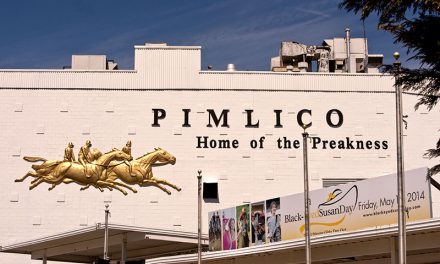by Kimberly K. Egan, Maryland Horse Council Co-President (first published in the May 2022 Equiery)
May is a big month for Maryland equestrians. No matter where you are in the state or what kind horse person you are, May is the month for you.
The big headliner is, of course, the Preakness Stakes at Pimlico on May 21, a tremendous event for MHC lifetime member The Maryland Jockey Club. The Preakness is the second leg of the Triple Crown and the shortest of the three races, at 9.5 furlongs. The Preakness is often where Triple Crown dreams go to die, as only 23 horses in the history of the series have won both the Kentucky Derby and the Preakness. The last Maryland-bred horse to win the Preakness was Deputed Testamony in 1983. There were 7 others before him – Cloverbrook in 1877, Dunboyne in 1887, Refund in 1888, Sly Fox in 1898, Challedon in 1939, Kuai King in 1966, and Bee Bee Bee in 1972. Many members will recall that MHC lifetime member Hidden Hills Farm & Vineyards has a wine named after Challedon.
May is not just for flat racing, though. May is also the month that our equestrian trails begin to put on their spring show, that the competition season gets into full swing, and that our horses start to look nice and shiny and fat as fields exhausted from the winter push up beautiful fresh forage grass. Which means May is also a muddy month, of course. To help us cope, our Farm Stewardship column this month (see page 47), has some great advice from the Maryland Department of Agriculture’s Office of Resource Conservation on how to manage Maryland mud. Everyone’s favorite topic.
May is also the month when our hard-working Government Relations committee finally gets a break from the madcap sprint that is the Maryland legislative session. The General Assembly sits for only 90 days a year, in Annapolis, but they work at breakneck speed during that time. Our Government Relations committee meets every week during session and dedicates countless hours to writing testimony, presenting at committee hearings, and working behind the scenes with legislators, lobbyists, and other constituents to try to get the best outcome for our industry. This year the session ended at midnight on April 11. The General Assembly considered 2,498 and passed 835 of them.
The Maryland Horse Council and the horse industry as a whole came out ahead in Annapolis. The majority of the bills that MHC supported passed, and all of the bills that we opposed either died in committee or were amended in such a way as to be palatable to our members. Our Government Relations column this month (see page 33) has a full session wrap-up. There is something for everyone in the new laws.
Another MHC victory on the government relations front is that we successfully lobbied Howard County to invest in much-needed repairs at Schooley Mill Park, the only public equestrian facility in the county. The arena at Schooley Mill Park is unusable much of the year because of significant drainage issues and generally poor footing. Show organizers had stopped holding schooling shows at the park, and many of our members stopped trailering in because the ground conditions were dangerous to horses. Howard County invited us to meet with the County Executive, the Recreations and Parks staff, and the capital funding team to better understand the problem and decide on a solution. The funds will be available as soon as July.
We owe a huge thank you to MHC member Lydia Liker for bringing the issue to our attention, to everyone who responded to our public survey on this issue, and to Howard County Executive Calvin Ball for his prompt attention to the needs of the local horse community.
Corinne M. Pouliquen and Kimberly K. Egan are the Co-Presidents of the Maryland Horse Council. You can reach Corinne at parkoverlookfarm@aol.com. You can reach Kim at kegan@mdhorsecouncil.org.











